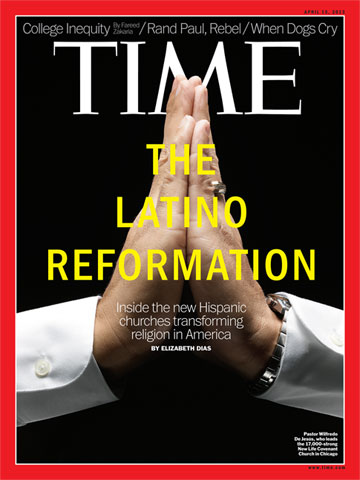
Sunday worship at Calvary Foursquare Church in Silver Spring, Md., starts in an empty parking lot. The congregants usually arrive on foot with well-worn Bibles in hand. They come in groups, Latino mothers and toddlers, grandparents and friends. "Que Dios te bendiga"--May the Lord bless you--each one says, offering hugs and kisses to everyone they meet. They board a refurbished school bus painted with a Bible verse and the church's Spanish name: Iglesia Cuadrangular el Calvario. When it pulls out into the busy street, I hop in my car and follow. Twenty minutes later, the bus makes a sudden left into another parking lot--this one 15 times as large, home to Trinity Assembly of God Church--and this place is packed. A dozen men in neon yellow jackets keep the cars from fighting for spaces. At least five people tumble out of every car and van, usually families of three generations, tambourines in tow. Hearing the singing from inside my car, I follow them through the sanctuary doors.
A giant flag bearing a lion with a waving mane of orange sunbeams hangs above the nearly 500 people inside. Trumpets sound, and guitars jam the alabanzas, Spanish songs of praise. A dozen girls dressed in white costumes with red sequined sashes dance onstage, and teenage boys step in unison below. Little children race to the front to join. One woman waves a fan with long pink sash, and a man pounds his fist on the pew as he prays. Then a white-haired woman has a prophecy. The pastor rushes the microphone to her, and everyone falls silent as she screams. "The Lord will heal people in this room today," she cries in Spanish. "Gloria a Dios! Praise be to God! The Spirit of the Lord is in this place." People kneel at the altar, the ministers anoint them with oil, and then the fiesta begins again.
The faithful at El Calvario are not Catholic; they are Protestants: born-again, Bible-believing, Latino Protestants. They represent one of the fastest-growing segments among America's churchgoing millions. According to the Pew Forum on Religion and Public Life, more than two-thirds of the 52 million-plus Latinos in the U.S. are Catholic; by 2030, that percentage could be closer to half. Many are joining evangelical Protestant congregations. Among young Latinos, the drift away from the Roman Catholic Church is even more rapid. It is a migration that is forcing both the Vatican and the Southern Baptist Convention to take notice. While many Anglo churches are struggling to retain members, congregations like El Calvario are booming: 18 months ago, the suburban Washington, D.C., church had 400 members. Now more than 800 people attend an array of services each week, and its leaders are planning a 3,000-seat sanctuary. The newly converted faithful even have their own name: they call themselves evangélicos.
